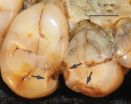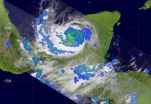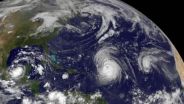Keywords: Philipsburg Batholith, Tibetan Plateau, Carpathians, Mojave-Snow Lake fault, hotspots, Moho.
Highlights are provided below. View abstracts for the complete issue of LITHOSPHERE at http://lithosphere.gsapubs.org/current.dtl.
Representatives of the media may obtain complementary copies of LITHOSPHERE articles by contacting Christa Stratton at the address above. Please discuss articles of interest with the authors before publishing stories on their work, and please make reference to LITHOSPHERE in articles published. Contact Christa Stratton for additional information or assistance.
Non-media requests for articles may be directed to GSA Sales and Service, gsaservice@geosociety.org .
Magnetic fabric, paleomagnetic, and 40Ar/39Ar geochronologic data bearing on the emplacement of the Late Cretaceous Philipsburg Batholith, SW Montana fold-and-thrust belt
Travis J. Naibert et al., University of New Mexico, Dept. of Earth and Planetary Sciences, Northrop Hall, MSC03 2040, Albuquerque, New Mexico 87131-0001, USA. Pages 303-327.
How large volumes of silicic magma are emplaced in and thus contribute to the growth of continental crust, in particular during time periods of overall crustal shortening, remains a question of considerable interest, according to Travis Naibert of the University of New Mexico and colleagues. The Late Cretaceous (ca. 75 Ma) Philipsburg Batholith in southwest Montana provides an excellent setting to study how large silicic plutons were emplaced in and toward the waning stages of shortening in this part of the Sevier fold-thrust belt of the western U.S. Cordillera. Magnetic fabric information obtained from 119 spatially distributed sites suggest that the batholith is a tabular body and that its emplacement involved subhorizontal magma flow controlled by local thrust faults, including the Georgetown-Princeton thrust, which served as conduits for magma ascent. The spatial distribution of magnetic fabric data is consistent with magma emplacement into a fault-bend fold at the top of a ramp in the Georgetown-Princeton thrust system. New 40Ar/39Ar thermochronologic data indicate that the entire Philipsburg Batholith was emplaced rapidly at about 74.8 plus or minus 0.1 Ma.
Limit of channel flow in orogenic plateaux
Patrice Francis Rey, The University of Sydney, School of Geosciences, Madsen Building, F09, Sydney, NSW 2006, Australia. Pages 328-332.
The eastward growth of the Tibetan Plateau has been attributed to the flow of the plateau's weak lower crust into its foreland over a distance of 1500 km in 15 million years. This channel-flow extrusion requires a very low-viscosity deep crust prior to thickening. Patrice Rey of the University of Sydney and colleagues show, through triaxial thin sheet models, that Tibet's uplift rate and plateau elevation demand a prethickening Moho temperature of 500-600 degrees Celsius. Such temperatures are incompatible with the viscosity necessary for channel-flow extrusion greater than 1000 km. Using two-dimensional coupled thermomechanical numerical experiments and prethickening temperatures compatible with Tibet's uplift history, they show that mass redistribution processes are dynamically coupled and that coupling is sensitive to rheology, channel buoyancy, and boundary conditions. Channel-flow extrusion velocities are limited to less than 1 cm/yr by cooling in the foreland and by any upward deviation of the weak channel by extension in the plateau or by erosion at the plateau margin. This study was funded in part by National Science Foundation grants EAR-0337488, EAR-0409776, and EAR-0838541.
Mantle earthquakes in the absence of subduction? Continental delamination in the Romanian Carpathians
Melvin Anderson Fillerup et al., University of South Carolina, Dept. of Earth and Ocean Sciences, 701 Sumter St., EWS 617, Columbia, South Carolina 29208, USA. Pages 333-340.
New geophysical data from the Eastern Carpathian mountains in Romania provide an image of the upper 200 km of Earth across this orogen and suggest that (1) the crust is anomalously thin beneath these mountains, (2) the lower crust and upper mantle ("lithosphere") may have dropped off a large region beneath the mountains, and (3) this descending material may be the source of large-magnitude, deep earthquakes in the Vrancea seismogenic zone of Romania. This geodynamic process, referred to as continental delamination, has long been hypothesized, but in only limited cases postulated in modern settings. If correct, these findings by Melvin Fillerup of the University of South Carolina and colleagues would demonstrate a mechanism other than subduction of oceanic lithosphere to generate seismicity in the upper mantle. This study was funded in part by NSF grant EAR-0310118.
Evaluating the Mojave-Snow Lake fault hypothesis and origins of central Sierran metasedimentary pendant strata using detrital zircon provenance analyses
Valbone Memeti, University of Southern California, Earth Sciences Dept., Office 304, Los Angeles, California 90089, USA. Pages 341-260.
Valbone Memeti of the University of Southern California and colleagues examined the origin of metasedimentary rock of the Snow Lake block in the central Sierra Nevada batholith, thought to be transported during the Cretaceous from the Mojave Desert near Victorville northwestward by the enigmatic Mojave-Snow Lake fault. Field mapping data and laser ablation-inductively coupled-plasma mass spectrometry U/Pb geochronology on detrital zircons from different pendants revealed that although the older metasediments are confirmed to be Proterozoic to early Paleozoic continental margin deposits, the overlying metasediments are of Jurassic age and were deposited in a marine environment, thus disagreeing with the originally proposed correlation. Without this correlation, the suggested 400 km of displacement along the Mojave-Snow Lake fault is unconstrained, the exact location of origin for the package of continental margin and Jurassic marine metasediments uncertain, and the nature of the contact between these two sediment packages, which has been suggested to be an angular unconformity, is speculative and deserving of a more detailed evaluation. This project was supported in part by National Science Foundation grant EAR-0537892.
Global pulsations of intraplate magmatism through the Cenozoic
Rolf Mjelde et al., University of Bergen, Dept. of Earth Science, Allegt 41, Bergen, 507, Norway. Pages 361-376.
It is well known that volcanic activity at Earth's hotspots (e.g., Hawaii, Iceland, and Afar-Kenya) varies with time. These variations have been attributed to a multitude of causes -- from thickness variations of the crust to deep mantle processes. This study by Rolf Mjelde of the University of Bergen and colleagues, which includes most of the hotspots active during the past 70 million years, indicates that they co-pulsate, with a dominant period of about 10 million years and a secondary period of about 5 million years. It is postulated that the apparent co-pulsation results from global fluctuations in core-mantle interaction, involving periodic heating of Earth's core with subsequent increases in global mantle plume activity.
Nature of the Moho transition in NW Canada from combined near-vertical and wide-angle seismic-reflection studies
Jounada Oueity, University of British Columbia, Earth and Ocean Sciences, 6339 Stores Road, Vancouver, British Columbia, V6T 1Z4, Canada. Pages 377-396.
Although 2009 marked one century since the discovery of the Moho, or crust-mantle boundary, the exact nature of that boundary and the manner in which it formed remain major uncertainties in lithospheric studies. In northwestern Canada, sharp Moho reflections at both near-vertical and wide-angle incidence have been imaged beneath the Great Bear magmatic arc. They show a remarkably flat Moho and do not reflect the complex tectonic history of the Wopmay orogen, of which the Great Bear arc is one part. In order to understand the origin of these reflections and the nature of the Moho, Jounada Oueity and R.M. Clowes of the University of British Columbia calculated near-vertical and wide-angle synthetic seismograms for a number of crust-mantle transition models using one- and two-dimensional wave propagation algorithms. Only laterally and vertically heterogeneous models can properly simulate the observed seismic signature recorded on both near-vertical and wide-angle reflection data. The heterogeneity is achieved by either laterally discontinuous layering or a lamellar structure with randomly distributed ellipses. These models suggest that the Moho represents a thermal/metamorphic front, a regional decollement, or both.
INFORMATION:
www.geosociety.org


